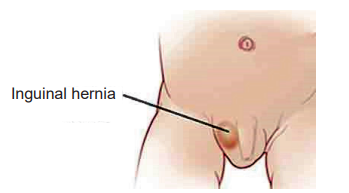Download and print as a PDF (279kB pdf)
On this page
What is a hernia?
A hernia is the bulge that occurs when there is a small defect in the muscles of the tummy. They can be in the groin or around the tummy button. The defect allows the intestines and soft tissues to protrude giving the appearance of a bulge in the skin. The bulge may not be noticeable all the time. When baby is sleeping, relaxed or lying down it may become smaller or disappear. When coughing, straining or crying the bulge may become larger and feel firmer.
An inguinal hernia occurs in the groin, the area between the top of the thigh and the tummy button. It can occur at any age in both sexes, but is much more common in boys born too early.

Why is an operation needed?
The hernia may have caused no problem or discomfort, but sometimes a small piece of intestine can become trapped in the defect and may become blocked. This causes pain and vomiting and could result in damage to the intestine. To prevent this, it is usual to surgically repair the defect in the muscle.
The operation is called a ‘hernia repair’ or ‘herniotomy’. The operation is usually performed a short while before your baby is ready to go home.
What happens before the operation?
The Surgeon will have seen your baby and will need to talk about the operation with you. The surgeon will explain the procedure and what they expect to find. They will ask you to read and sign a consent form. The operation is performed here at the Royal Alexandra Children’s Hospital.
An anaesthetist will care for your baby during the operation. Your baby may have a general anaesthetic (be asleep) or local anaesthetic (the area will be numbed). During the operation your baby will feel no pain or discomfort.
What happens during the operation?
The surgeon makes a cut in the skin near to where the bulge occurs, through which the defect in the muscle is repaired rather like darning a hole in a sock. The wound in the groin is closed at the end of the operation with stitches. These stitches are below the surface of the skin and will eventually dissolve on their own. The wound maybe covered with a waterproof clear plaster.
What happens after the operation?
Your baby will usually be transferred back to the same nursery and bed space. As every baby is different your baby may need a little extra breathing support or have an increased oxygen requirement afterwards while they recover. Your baby will be monitored by their nurse and will start feeding again following the Surgeons instructions. Your baby maybe given some Paracetamol if they appear to be in discomfort.
Are there any risks?
These will be discussed with you by the Surgeons when they take consent and also by the Anaesthetist and may include:
• Infection
• Bleeding
• Recurrence of the problem.
Getting back to normal
Baths can start the day after the operation but please avoid soaking the wound for a long time. If a waterproof dressing is covering the wound, it can be removed after 5 days. Your baby may experience some bruising and tenderness around the wound, this will settle with time.
What about follow up?
Your baby will be followed up in the outpatient clinic by the Neonatal and Surgical teams at 6 to 8 weeks after discharge and you will of course be seen by your health visitor at home.
The nurse and neonatal team looking after your baby will be happy to answer any further questions you may have.
Trevor Mann Baby Unit
01273 696955
Ext. 64377
This leaflet is intended for patients receiving care in Brighton & Hove or Haywards Heath.
The information in this leaflet is for guidance purposes only and is in no way intended to replace professional clinical advice by a qualified practitioner.